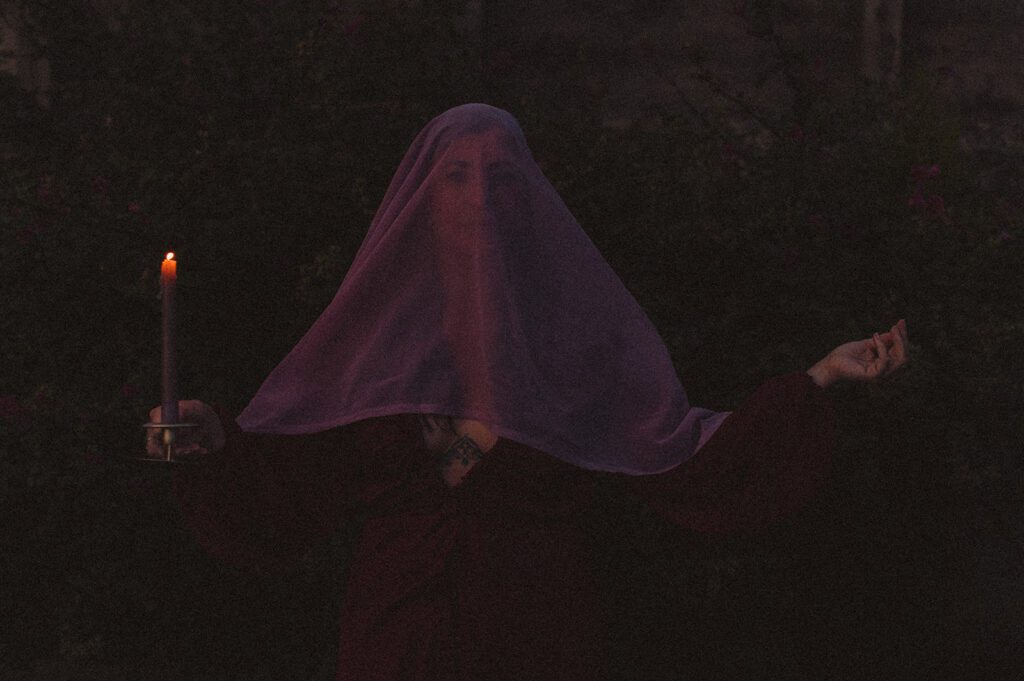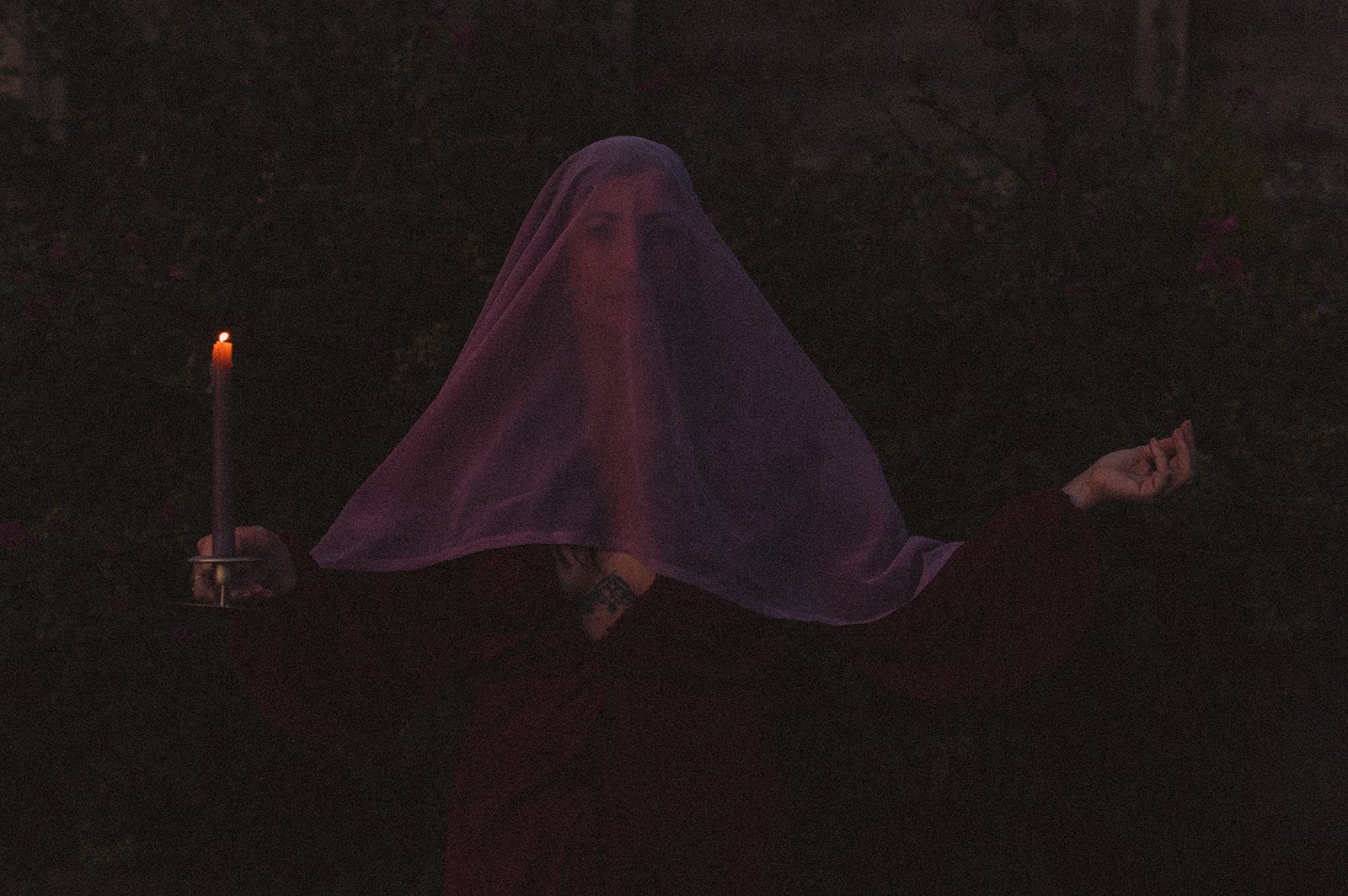In this blog, I’m going to describe who the dark feminine is and what dark feminine energy looks like.
I’m the creator of an online underworld journey called Dark Feminine Medicine, which takes place over 7 weeks, beginning with the Winter Solstice on December 21st.
DFM is inspired by the shifts I’ve noticed in women who begin to cultivate a relationship with hidden aspects of the feminine.
Most of us can understand how, through the lens of Yin, the feminine aligns with the quality of darkness…
(Yin and Yang are concepts within the Daoist cosmology, describing the two halves of a cycle of opposing yet interconnected forces underpinning the universe. Yin is the feminine; Yang is the masculine. Yin is characterised as slow, cold, dark, wet and receptive.)
… but despite this, many of us feel slightly uncomfortable with the dark feminine.
She has a bad rap as the femme fatale or the siren; someone mothers would warn their sons about. But there’s so much more to her than that.

DFM is inspired by the shifts I’ve noticed in women who begin to cultivate a relationship with hidden aspects of the feminine.
The Feminine is Dark
In order to thrive as women, we need to cultivate yin. This is how we support our physiology.
We enter deep yin states during orgasm, menstruation and childbirth where our body descends our consciousness into the root – our primal centre.
In these yin states, we’re open to receive, to go into the mystery and to access a field of non-linear wisdom as it arises through the body.
The feminine has always had a special relationship with darkness: the dark of the moon; the dark of the womb, the life-giving, generative powers of the fertile soil.
Our ancestors worshipped a primary dark feminine deity.
And yet, we’ve been entrained to disconnect from our own darkness at great cost to our wellbeing, eros and creativity.
Our culture is yang-dominant & solar-oriented. We are a people afraid of the dark and encouraged to shy away from what dwells in the shadows.
Why? Because through dark feminine energy, women unearth an aspect of the psyche which has been buried for so long, its collective remembering threatens the status quo.
Light Feminine Energy
Typically, women were encouraged to cultivate light feminine qualities – those which make them best able to perform the duties expected of them in more traditional roles: nurturing, mothering, fertility, gentleness – at the expense of their dark feminine.
And, for hundreds of years, she was exiled.
When the great mother goddess was split into light & dark; upper-world and under-world, feminine consciousness fractured.
Those who did not choose to abandon her were called mad women, sluts, witches.
Women shut away their dark feminine aspects and wondered why their words became stuck in their throats.
Whilst we can’t split women into the binary of light and dark, we can examine the ways that women have been culturally and socially advised to turn away from the darker aspects of the feminine.
And as we dig deeper, we find that the further down we go into the history of the dark feminine as a dark mother earth goddess – embodied by ancient goddesses like Isis, Aditi, Kali – the closer we come to the root of why dark feminine energy has been so badly suppressed.

The church stole and inverted the symbols of the goddess.
When God Was a Woman
Archaeological evidence shows that God was considered female for the first 200,000 years of human life on earth. Primary female deities were worshipped for millennia by peaceful, matrilineal societies.
Neolothic civilisation was disrupted by proto-Indo-European nomadic tribes, ruled by warriors who worshipped male gods and conquered the people of the Goddess. Monotheistic religion took over from paganism and the symbol of a pregnant goddess adorned with the blood of birth became Jesus on the cross, covered with the blood of pain.
The church stole and inverted the symbols of the goddess. Her serpent familiar was transformed from ally to evil-doer in the book of Genesis, whispering dark feminine secrets into Eve’s ear.
As a symbol of regeneration and life-birth-death cycles, the snake undermined the founding idea of monotheism: God is in charge.
And, by default, woman – with her ties to the hidden realms of regeneration and mystery, where menstruation, birth and sex occur – was also seen as sinful.
For centuries women have been severed from the sacred dark, split off from the innate power of their primal root centres and innate oracular gifts; separated from their wombs and yonis, their sex and their cycles.
Is the dark feminine making herself known at this interesting time in human history to tell us something about the buried wisdom that it’s time to unearth?
Embodying Dark Feminine Energy
When we embody dark feminine energy we are calling forth the memory of a time when the dark feminine was worshipped as the great mother goddess of earth.
- We do this by being willing to go into the mystery.
- We do it when we honour yin, the dark moon, the sacred pause.
- We do it when we face our shadow.
- We do it when we soften into deep, dark, earthy love.
- We do it when we allow ourselves to be human.
- We do it when we embrace dark feminine energy.
Dark feminine energy invites women called by the chthonic currents to reclaim the sacred dark as a wellspring of feminine wisdom, eros and magick.
It asks us to embrace the sacred dark in all its forms: rest, depth, descent into the body, emotional expression and truth-telling. And by leaning back into the currents of dark feminine energy, something in us heals and rewires, we become wilder, earthier and more human. More woman. And in the truest sense, we become more feminine.
If you’d like to join the waitlist for Dark Feminine Medicine: the 7-Week Underworld Journey this winter, click here.

Comments +